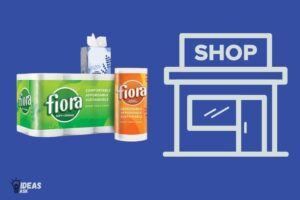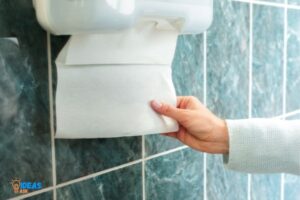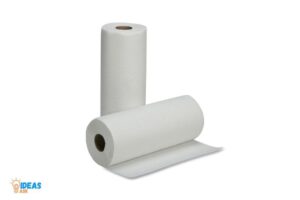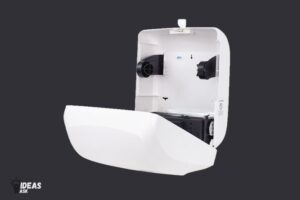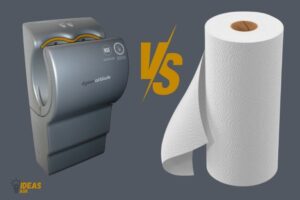How Absorbent Are Paper Towels? Highly Absorbent!
Paper towels are highly absorbent due to their manufacturing process that creates a network of small spaces, or capillaries, that can hold a large amount of liquid relative to the towel’s weight.
Paper towels are made from pulp, which is a material that comes from softwood trees. The pulp is put through a process that converts it into a very thin and flexible material.
This material is then embossed with a pattern to create air pockets, which increases the surface area of the towel, and hence, its ability to absorb liquids. These microscopic spaces allow the towel to absorb a substantial amount of liquid rapidly.
In essence, the high absorbency of paper towels stems from their unique structure and manufacturing process. The process creates a vast network of tiny spaces that can hold a large volume of liquid rapidly.
This structural feature, combined with the soft and flexible nature of the pulp-based material, makes the humble paper towel an effective tool for absorbing spills and cleaning surfaces.
Absorbency Comparison Of Various Brands of Paper Towels
| Paper Towel Brand | Absorbency (ml of liquid) |
|---|---|
| Brawny | 50 |
| Bounty | 45 |
| Sparkle | 40 |
| Viva | 38 |
| Scott | 35 |
| Great Value | 32 |
| Kirkland Signature | 30 |
Key Takeaway
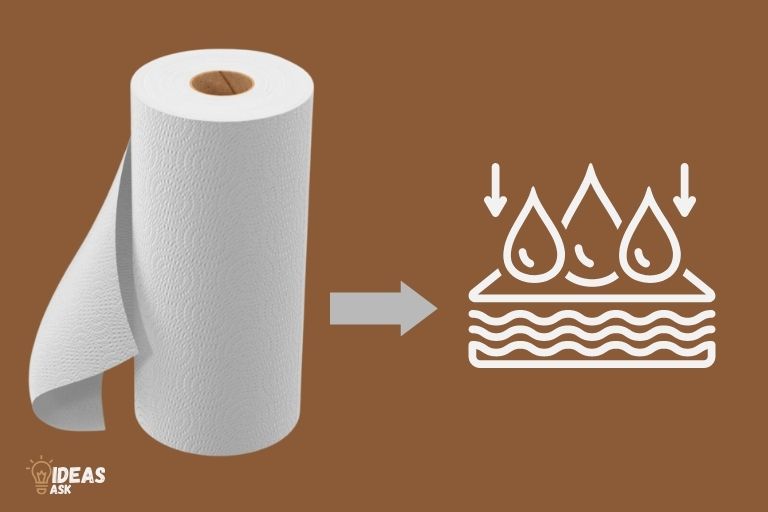
Five Facts About the Absorbency of Paper Towels
How Absorbent Are Paper Towels Relative To Other Materials?
When it comes to cleaning up spills or wiping surfaces, paper towels are the go-to choice for many individuals. But how absorbent are paper towels compared to other materials?
We will explore the absorbency of paper towels in comparison to cloth towels, the advantages and disadvantages of paper towels, and factors that influence their absorbency.
Comparison Between Paper Towels And Cloth Towels
- Cloth towels are reusable, whereas paper towels are disposable.
- Cloth towels are eco-friendly, while paper towels are not.
- Paper towels are more effective in absorbing liquids than cloth towels.
- Cloth towels are more suitable for cleaning surfaces due to their durability and versatility.
- Paper towels are preferred in environments that require high levels of sanitation, such as hospitals or clinics.
Advantages And Disadvantages Of Paper Towels
Advantages:
- Convenience: They are easy to use and dispose of when cleaning up spills.
- Hygiene: They are disposable, reducing the risk of cross-contamination.
- Cost-effective: They are affordable and readily available in stores.
- Effectiveness: They are highly absorbent, making them ideal for cleaning up spills quickly.
Disadvantages:
- Environmental impact: They are not eco-friendly and contribute to landfill waste.
- Cost: Overuse of paper towels can lead to unnecessary expenses.
- Quality: Not all paper towels are created equal, and some may not be as absorbent as advertised.
- Health hazards: Some paper towels contain harmful chemicals that can cause skin irritation or other health problems.
Factors Affecting Absorbency Of Paper Towels
- Pulp quality: The quality of the pulp used in making paper towels has a significant impact on their absorbency. Too much recycled pulp can reduce the towel’s ability to absorb liquids.
- Paper thickness: Thicker paper towels are more absorbent than thinner ones.
- Embossing: Paper towels that are embossed or textured absorb liquids more effectively than those that are not.
- Ply: Paper towels with more plies have higher absorbency than single-ply towels.
- Additives: Some paper towels contain additives such as lotion or scent, which can affect their absorbency.
Paper towels are highly absorbent and effective in cleaning up spills quickly. However, they have some environmental downsides and can be costly in the long run.
When it comes to choosing between paper towels and cloth towels, it ultimately comes down to personal preference and the intended use.
Testing Absorbency Of Paper Towels
How Absorbent Are Paper Towels
When it comes to cleaning up spills and messes at home or in the workplace, paper towels are a go-to choice for many.
With their absorbent properties, they are designed to effectively soak up liquids and leave surfaces dry, making them an essential tool for maintaining a clean and hygienic environment.
But just how absorbent are paper towels? In this post, we will explore the testing methods used to measure the absorbency of paper towels.
Experimental Approach To Testing Absorbency
To test the absorbency of paper towels, an experimental approach is taken. This approach involves measuring the amount of liquid that a paper towel can absorb and retain.
The following is a brief overview of the experimental process:
- First, a specified amount of liquid is poured onto a flat surface
- Next, a paper towel is placed on top of the liquid
- Pressure is applied to the paper towel using a specified weight or force
- The amount of liquid that the paper towel absorbs is measured by weighing the towel before and after absorption
Describing Methodology
There are a few different testing methods used to measure the absorbency of paper towels. One method involves using a beaker to hold the liquid and a graduated cylinder to measure the amount of liquid.
The paper towel is then placed on top of the beaker and allowed to absorb the liquid for a set amount of time.
Another method involves using a pipette to drop small amounts of liquid onto the paper towel until it is fully saturated.
Data Analysis And Interpretation
Once the absorbency test is complete, the data is collected and analyzed to determine how absorbent the paper towel is.
The amount of liquid absorbed is typically reported as a percentage of the total amount of liquid applied.
Additionally, other factors such as wet strength, thickness, and durability may also be considered when interpreting the results.
Understanding the absorbency of paper towels is essential in selecting the right product for your cleaning needs.
By utilizing experimental testing methods and analyzing the resulting data, researchers can determine the effectiveness of paper towels and make recommendations for their use.
So the next time you reach for a paper towel, remember the science behind its absorbent properties.
Practical Applications Of Paper Towel Absorbency
Have you ever wondered how absorbent paper towels really are? Paper towels are incredibly useful for a range of purposes, from cleaning up spills to drying your hands.
But with so many different brands and types of paper towels on the market, it can be difficult to know which one is right for you.
We’ll explore the practical applications of paper towel absorbency and how it can impact our daily lives.
Household Use Of Paper Towels
- Paper towels are a staple in many households. They’re perfect for cleaning up spills, wiping down surfaces, and drying dishes.
- When it comes to household use, absorbency is a major factor in determining the effectiveness of a paper towel. The more absorbent the towel, the easier it is to clean up messes and dry surfaces.
Some common uses for paper towels in the household include:
- Cleaning up spills and messes on the floor or countertops
- Drying dishes and glassware
- Wiping down surfaces and appliances
- Removing excess moisture from fruits and vegetables
Industrial Use Of Paper Towels
- Paper towels are also commonly used in industrial settings for cleaning up spills and maintaining machinery.
- In industrial use, the absorbency of the paper towel is critical to ensuring that it can effectively clean up spills and prevent damage to machinery.
Some common uses for paper towels in an industrial setting include:
- Cleaning up oil and chemical spills
- Drying and cleaning machinery
- Wiping down surfaces and workstations to maintain cleanliness
- Removing pollutants from the air
Environmental Considerations
- While paper towels are incredibly useful, it’s important to consider the impact they have on the environment.
- The production and disposal of paper towels can be harmful to the environment. In addition, many paper towels are made from non-renewable resources such as trees.
- However, there are eco-friendly options available on the market. Some paper towels are made from recycled materials, and others are biodegradable.
- When using paper towels, it’s also important to use them responsibly and minimize waste. This can include using a cloth towel instead of a paper towel when possible, or using a reusable cloth instead of disposable paper towels.
How Absorbency Affects Consumer Decision-Making
- In a world where we’re constantly bombarded with choices, the absorbency of a paper towel can be a major factor in consumer decision-making.
- Consumers want a paper towel that can effectively clean up spills and dry surfaces without leaving a mess behind. As a result, absorbency is a key factor that many consumers consider when choosing a paper towel.
- Brands that highlight the absorbency of their paper towels in their marketing and packaging often stand out to consumers and may be more likely to be chosen over less absorbent options.
Absorbency is a critical factor to consider when choosing a paper towel for household or industrial use.
While there are environmental considerations to keep in mind, there are also eco-friendly options available on the market. Ultimately, it’s important to choose a paper towel that meets your specific needs and preferences.
Future Directions In Paper Towel Technology
Current Innovations In Paper Towel Absorbency
Paper towels have come a long way since their inception. Today, manufacturers have come up with innovative solutions for ultra-absorbent paper towels.
Here are some of the current innovations in paper towel absorbency:
- Air-infused technology: This technology creates tiny air pockets between the fibers of the paper towel, increasing absorbency power.
- Multi-layered sheets: Paper towels now come in thicker, multi-layered sheets that can hold more liquid.
- Moisture-activated ridges: Some paper towels have ridges that become more absorbent when wet, making them ideal for cleaning spills.
Potential Future Developments
As technology continues to evolve, there are many potential future developments in paper towel technology.
Here are some possible examples:
- Nanotechnology: Researchers are exploring the use of nanotechnology to create paper towels that can absorb even more liquid. Nanoparticles can be added to the paper towel fibers to improve their absorbency.
- Super-absorbent polymers: These are materials that can hold onto water and liquids many times their weight. If incorporated into paper towels, they could improve their absorbency.
- Biodegradable paper towels: Many manufacturers are looking to create biodegradable paper towels that can reduce environmental waste. Future developments may improve the durability and absorbency of these eco-friendly options.
Impact On Industry And Consumer Use
Innovations and future developments in paper towel technology can have a significant impact on industry and consumer use.
Here are some potential impacts:
- Improved efficiency: More absorbent paper towels can reduce the number of sheets needed to clean spills, resulting in cost savings.
- Market advantages: Manufacturers with superior absorbent technology may gain an advantage in the competitive paper towel market.
- Environmental benefits: Biodegradable paper towels can have a positive impact on the environment by reducing waste and promoting sustainability.
Overall, innovations and future developments in paper towel technology have the potential to improve absorbency, efficiency, and environmental impact for both industry and consumers.
FAQ On the Absorbency of Paper Towels
How Do Paper Towels Absorb Water Better Than Other Materials?
Paper towels are made of cellulose fibers that act like a sponge by creating capillary action, which allows them to draw water into their porous structure.
How Can I Test The Absorbency Of A Paper Towel?
Take a specified amount of water and pour it on the paper towel at a specific location, then calculate how much water was absorbed by that spot.
What Factors Affect The Absorbency Of Paper Towels?
The thickness of the paper towel, the type of fiber it’s made from, the density of the paper, and the surface area all affect its absorbency.
Are Recycled Paper Towels Less Absorbent Than Regular Ones?
Recycled paper towels have similar absorbency to regular paper towels due to the refining process that breaks down the fibers and creates new ones to maintain their absorbency.
Conclusion
To sum it up, paper towels are an efficient and highly absorbent tool for cleaning up spills and messes in our daily lives.
From soaking up water spills on the kitchen floor to wiping down wet surfaces, paper towels offer us a quick and hassle-free solution to our cleaning needs.
Through this article, we have learned about the various types of paper towels available in the market and how their absorbency varies.
It is important to choose the right type of paper towel to get the maximum benefits out of it. Moreover, we have also looked into ways of making paper towels more environmentally friendly and sustainable.
By reducing our dependency on paper towels and switching to eco-friendly options, we can take small but significant steps towards a greener future.
Therefore, with careful usage and proper disposal, paper towels can continue to serve as an indispensable tool for us while being mindful of our environment.

